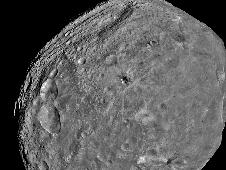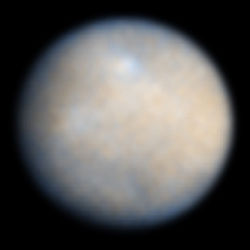NASA’s Dawn spacecraft begin the first of many dedicated science focused orbits over the main asteroid object 4 Vesta this week. The plucky little ion powered probe will study Vesta for the next couple of years before lighting up its revolutionary drive and breaking orbit for a rendezvous with the dwarf planet Ceres in 2015. The image of Vesta to the right was taken on 24 July 2011. Click to embiggen offsite.
Christopher Russell, the principal investigator of the mission, told me a few weeks ago, “”I and the Dawn team right now feel like Christopher Columbus and his crew must have felt after putting their faith in their three little ships and finally seeing the American shore ahead.” Russell, who invested 15 years of his own life into designing and managing the ambitious mission, added, “Like Columbus we have a very modest expedition conveyed by three little ion engines, but those little engines were quite sufficient for us to make the journey. The moment is profound and it is exciting to be finally at Vesta!”
Dawn will now begin sending detailed data to mission controllers and eager planetary astronomers using a suite of instruments on board. Via the Dawn NASA homepage:
In addition to the framing camera, Dawn’s instruments include the gamma ray and neutron detector and the visible and infrared mapping spectrometer. The gamma ray and neutron detector uses 21 sensors with a very wide field of view to measure the energy of subatomic particles emitted by the elements in the upper yard (meter) of the asteroid’s surface.
Vesta is super exciting for us space-science aficionados. It was immortalized in Isaac Asimov’s classic sci-fi short story Marooned OffVesta. Ceres even more so as it could be loaded to bear with ices, metals, and other substances useful to voracious, inefficient human metabolisms or our future machine surrogates. It’s a mystery, for starters the best images we have of Ceres look like the one to the left. Not a lot of detail. Dawn’s cameras will fix that just like they did for Vesta. Arghhh! The mission team has been working on Dawn for over a decade, so I suppose four years isn’t all that long. Between New Horizons at Pluto and Dawn at Ceres, 2015 is shaping up to be worth waiting for.
In the meantime, I found out one interesting fact about Ceres while researching the little world: its day is about eight to nine hours long and the surface gravity is less than three percent earth normal. That means we have a convenient, potentially resource laden world placed on the edge of the outer solar system where a space elevator might be practical using present day materials.



he heh..
“Ceres even more so as it could be loaded to bear with ices, metals”
I think that’s “FOR” bear…